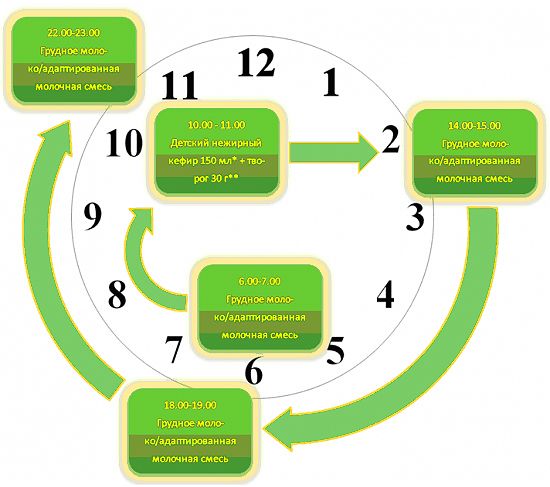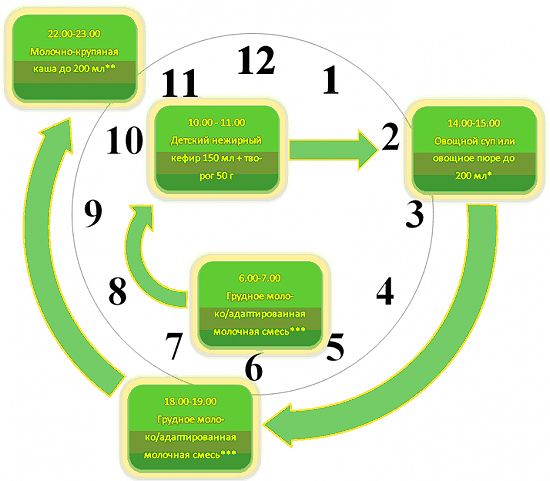Medical expert of the article
New publications
Feeding according to Komarovsky
Last reviewed: 04.07.2025

All iLive content is medically reviewed or fact checked to ensure as much factual accuracy as possible.
We have strict sourcing guidelines and only link to reputable media sites, academic research institutions and, whenever possible, medically peer reviewed studies. Note that the numbers in parentheses ([1], [2], etc.) are clickable links to these studies.
If you feel that any of our content is inaccurate, out-of-date, or otherwise questionable, please select it and press Ctrl + Enter.
Complementary feeding according to Komarovsky has recently become a very popular topic of conversation among pregnant women and happy mothers of infants. Dr. Komarovsky has gained fame as one of the best and most charismatic pediatricians of the post-Soviet era. His advice is listened to not only by young mothers, but also by those who have decided to have a second or even third child. He has his own view on how to properly start feeding babies. Firstly, he advises doing this no earlier than the sixth month of the child's life. Secondly, he believes that it is more important for a mother to pay attention to her own balanced diet than to introduce adult food in the fourth month (as most parents do).
Introduction of complementary feeding according to Komarovsky
Before delving into the diagrams and tables that Dr. Komarovsky offers to young parents, it is necessary to understand what complementary feeding is. Many mothers do not quite understand the meaning of this word, especially since pediatricians usually call any additional feeding by it. For example, if a woman has too little milk and she is offered milk formulas for her child, then this is not complementary feeding, but supplementary feeding. By the way, in this case, milk formula can easily be replaced with milk from domestic animals.
If you are trying to add "adult food" to your baby's diet, which will complement the milk, then this is already complementary feeding. According to Komarovsky, this must happen on time. In addition, it is important to choose the right food so that the child can wean better from the breast.
The introduction of complementary feeding according to Komarovsky should begin at the age of six months, despite the fact that many adults (and even pediatricians) recommend accustoming to regular food as early as possible. But if you want your baby to be healthy, then you should forget about outdated nutrition patterns and keep up with the times.
Why did complementary feeding begin earlier just 20-30 years ago? Dr. Komarovsky gives a clear and simple explanation for this. The fact is that when a woman ran out of milk in Soviet times, animal milk or various mixtures were added to the baby. For hygienic purposes, they were boiled, which led to the evaporation of all the necessary vitamins and minerals. This made the baby unhealthy, he developed hypovitaminosis and underweight. Even those nursing mothers who had enough milk did not eat well enough at that time to provide their child with everything necessary. That is why they tried to start complementary feeding even at two or three months.
Complementary feeding according to Komarovsky should be started with a small amount of products, because caution does not hurt here. Do not forget to feed with the food that is considered more familiar to the child (milk formula or mother's milk). You should carefully monitor the reaction of the small organism: whether a rash appears, whether the baby sleeps well, and so on. If there are no negative manifestations, you can gradually increase the dosage. If there are problems, it is better to consult a doctor and postpone complementary feeding.
Remember that it is better not to start adding new products immediately after the child is sick or after vaccinations. Do not force the baby or feed products by force.
Complementary feeding according to Komarovsky by month
Complementary feeding according to Komarovsky by month must be carried out exactly as shown in the diagram. It is also very important to monitor your baby's reaction.
6 months
The feeding scheme is as follows:
6-7 am: Store-bought formula or breast milk.
10-11 am: 150 ml low-fat baby kefir with 30 g low-fat cottage cheese.
14-15 days: Store-bought formula or breast milk.
6-7 pm: Store-bought formula or breast milk.
10-11 pm: Store-bought formula or breast milk.

To avoid problems with introducing kefir into a child's diet, you must first give 4 teaspoons and immediately supplement with store-bought formula (breast milk). It is very important to observe how the child reacts to the product. If the reaction is normal, you must gradually increase the dose every day, feeding him with his usual food.
As soon as you reach 150 mg of kefir per day, you need to start introducing cottage cheese. Here, too, it is very important to do it gradually, so that the child gets used to it. If desired, you can add sugar to the cottage cheese + kefir mixture. This rhythm is maintained until the child is 7 months old.
7 months
6-7 am: Store-bought formula or breast milk.
10-11 am: Old recipe for low-fat baby kefir with cottage cheese.
14-15 days: Store-bought formula or breast milk.
6-7 pm: Store-bought formula or breast milk.
10-11 pm: Cereal porridge with milk (no more than 200 ml).

Before bedtime at night is the best time to add the next product to the complementary feeding. Cereal porridges with milk are an excellent option. Here, special attention should be paid to buckwheat, rice and oatmeal. To introduce new food, you need to start with a small amount again (4 teaspoons). If there are no problems, we increase the dose.
 [ 4 ]
[ 4 ]
8 months
6-7 am: Store-bought formula or breast milk.
10-11 am: Old recipe for low-fat baby kefir with cottage cheese.
14-15 days: Soup or vegetable puree (no more than 200 ml).
6-7 pm: Store-bought formula or breast milk.
10-11 pm: Old routine with cereal porridge and milk.
Remember that you can start giving vegetables to your baby only after he has at least one tooth. It is best to leave puree or vegetable soup for the third feeding, which takes place during the day. To see how the child's body will react to vegetables, you first need to give the baby a little broth. Increase the amount every day. If the reaction is normal, you can switch to soups/puree.
Three weeks after introducing vegetable soup, you can try meat broth (it is better to choose chicken meat). If the child's reaction is positive, you can start adding mashed meat or hard-boiled egg yolk. But remember that it is better not to give more than half a yolk before 1 year.
For the second feeding, you can increase the amount of cottage cheese (up to 50 g).
9 months – 1 year
6-7 am: Store-bought formula or breast milk.
10-11 am: Old recipe for low-fat baby kefir with cottage cheese.
14-15 days: Old pattern of puree or vegetable soup (possibly with meat or yolk).
6-7 pm: Store-bought formula or breast milk.
10-11 pm: Cereal porridge with milk.

You can make soups or vegetable puree with any meat, but make sure it is lean. If you make potato puree, you need to pour milk over it and add pieces of mashed meat. Starting from the 10th month of life, you can try replacing meat broth with fish broth. Vegetable oil can be added to food.
You can add some fruit (soft) to cereal porridges with milk. Try to feed your baby breast milk at least once a day until the age of one. You can continue to give formula milk until the age of two.
Complementary feeding table according to Komarovsky
The complementary feeding chart according to Komarovsky helps to better understand how to properly add various “adult foods” to a child’s diet. But do not think that the doctor gives a full-fledged scheme with columns and rows, which contain special rules that are suitable for everyone. The “table” is an inaccurate description. Komarovsky only gives advice, but each parent should pay attention to their child’s reaction and act in accordance with it. In addition, the complementary feeding chart described above is quite understandable.
The first product the doctor recommends introducing is low-fat kefir. Fermented milk products are the best for starting complementary feeding because they have a very similar composition to what your baby is already used to. In addition, the bacteria that live in fermented milk products help the growing body cope with infections faster and better. They also reduce the load on the young liver and improve digestion processes.

